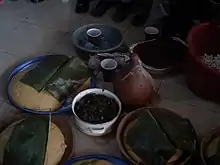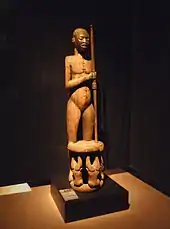Kom (peuple)
Les Kom sont une population du Cameroun vivant dans le Grassland[1]. On les considère aujourd'hui comme l'un des sous-groupes des Tikar[2].
Cet article concerne le peuple kom. Pour la langue kom, voir kom (langue des Grassfields).
Pour les articles homonymes, voir Kom.
Ethnonymie
Selon les sources et le contexte, on observe plusieurs formes : Bamekon, Bekom, Bikom, Itangikom, Kong, Nkam, Nkom[3].
Langue
Ils parlent une langue bantoue, le kom, dont le nombre de locuteurs était estimé à 233 000 en 2005[4].
Société
Contrairement à celle des Tikar, leur société est matrilinéaire[2].
Économie
Ce sont des agriculteurs et des pêcheurs[2].
Danse traditionnelle, Njang
Notes et références
- Selon Mohamad Z. Yakan, les Kom seraient également présents dans le nord-est de la République démocratique du Congo et dans d'autres pays limitrophes ((en) Mohamad Z. Yakan, « Kom », in Almanac of African Peoples & Nations, Transaction Publishers, New Brunswick, N.J., 1999, p. 432 (ISBN 9781560004332)). Cependant cette information n'est pas confirmée par d'autres sources.
- (en) « Kom », in James Stuart Olson, The Peoples of Africa: An Ethnohistorical Dictionary, Greenwood Publishing Group, 1996, p. 293 (ISBN 9780313279188)
- Source Bibliothèque du Congrès
- (en) Fiche langue
[bkm]dans la base de données linguistique Ethnologue. - (en) Christraud M. Geary, « Memorial figure of a queen mother : Kom kingdom, Cameroon, mid-19th century », in Africa: the art of a continent: 100 works of power and beauty, Guggenheim Museum Publications, New York, 1996, p. 154-155
Voir aussi
Bibliographie
- (en) Fred Ferretti, Afo-A-Kom : sacred art of Cameroon, Third Press, New York, 1975, 145 p. (ISBN 0893881341)
- (en) Walter Gam Nkwi, African modernities and mobilities : an historical ethnography of Kom, Cameroon, c. 1800-2008, Langaa Research & Publishing CIG, Mankon, Bamenda, Cameroon, 2015, 415 p. (ISBN 978-9956-762-72-9)
- (en) Paul Nchoji Nkwi, Traditional government and social change : a study of the political institutions among the Kom of the Cameroon Grassfields, University Presse, Fribourg, 1976, 233 p. (ISBN 9783827101150) (thèse)
- (en) Paul Nchoji Nkwi, « The Kom Palace : its foundation, growth and significance », in Paideuma (Wiesbaden, Allemagne), 31, 1985, p. 105-110
- (en) Tamara Northern, « The royal memorial figures from Kom », in Art of Cameroon, Smithsonian Institution, Washington, DC, 1984, p. 94-97
- (en) Jerôme Nsom, « Rites of passage in the Western Grassfields : Kom », in Patrick Mbunwe-Samba (dir.), Rites of passage and incorporation in the western grassfields of Cameroon, vol. 1, Kaberry Research Centre, Bamenda (Cameroun), 1993, p. 139-145
- Louis Perrois et Jean-Paul Notué, Rois et sculpteurs de l'ouest Cameroun : la panthère et la mygale, Éd. Karthala, Éd. de l'Orstom, Paris, 1997, 388 p. (ISBN 2-7099-1361-5)
- (en) Eugenia Shanklin, « The path to Laikom : Kom Royal court architecture », in Paideuma (Wiesbaden, Allemagne), 31, 1985, p. 111-150
- (en) Jacqueline de Vries, Catholic mission, colonial government and indigenous response in Kom (Cameroon), African Studies Centre, Leyde (Pays-Bas), 1998, 126 p. (ISBN 9054480343) (texte remanié d'une thèse)
- (de) Verena Westermann, Women's disturbances : der Anlu-Aufstand bei den Kom (Kamerun) von 1958-1960, Lit, Munster, 1992, 190 p. (ISBN 3-89473-108-7)
Articles connexes
Liens externes
- (en) Portail des Kom
- (en) Kom (Christopher D. Roy, Université de l'Iowa)
- Portail de l’anthropologie
- Portail du Cameroun
Cet article est issu de Wikipedia. Le texte est sous licence Creative Commons - Attribution - Partage dans les Mêmes. Des conditions supplémentaires peuvent s'appliquer aux fichiers multimédias.







